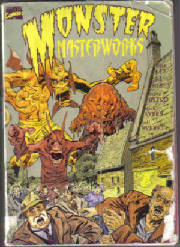 |
| click on photo for larger view |
|
|
| JLA # 9 presented origin of the group |
A memorable annual tradition was initiated in issues #21 – 22 when the Justice Society
came out of retirement and traveled from their alternate earth to ours (and vice versa) so that they could interact with the
JLA and battle each other's villains. The second annual JLA-JSA adventure (# 29 – 30) introduced the evil Crime Syndicate
of Earth-3, with characters that resemble Superman (Ultra Man), Batman (Owl Man), Wonder Woman (Superwoman), Flash (Johnny
Quick) , and Green Lantern (Power Ring). [Forty years later these same villains are to be featured in the current issues of
Justice League of America!]
The JLA underwent quite a few changes over the years.
They ran for several hundred issues, which ended with most of the members being replaced by more relevant, hipper –
and less interesting -- younger heroes in a Detroit setting. The JLA was then restarted with a new first issue and most of
the same old heroes, although it soon degenerated into a parody comic book which had its amusing aspects but was too self-consciously
(instead of charmingly) silly. Many new characters of widely varying effectiveness were created or added to the group. These
comics were popular, however, and created such spin offs as Justice League Europe and Justice League International,
which were a little more serious at times. These, too, were eventually canceled, and the series was started all over again,
this time told straight, but with so many different artists, writers, and directions over the years it has had trouble maintaining
any kind of consistency. Still, the comic remains popular.
Meanwhile on television, the Cartoon Network introduced
a rather excellent series entitled Justice League. An uneven, but quite classy cartoon show for kids of all ages, the
series was lovingly presented by obvious fans who knew all about the rich history of the league (in fact, most children probably
couldn't appreciate how carefully the writers of the series “borrowed” concepts and characters from stories originally
published in comic books decades before they were born). Of course, not every episode was memorable, but some were remarkably
excellent, including the JLA's battles with the Secret Society of Super-Villains; a battle in the
past against the sinister and ancient Vandal Savage (guest-starring the Blackhawks); a story involving
a plague that would kill off every man (and only men) in the world; and a show entitled “Paradise Lost,” which
featured a genuinely thrilling battle between the JLA and demonic forces under Wonder Woman's Paradise Island. “Legends”
introduced a new group of heroes, The Justice Guild, which turned out to be the materialization of a boy's fantasies on a
dead planet. One episode featured a more ruthless version of the JLA from an alternate time line, and another had them interacting
with the evil Darkseid and other characters created by artist-writer Jack Kirby in the 1970's.
This wonderful show has recently been replaced by
a new series entitled Justice League Unlimited, which is a dumbed-down and disappointing new showcase for these great
characters. JLU features dozens of heroes, so many that it's impossible for the viewer to form any kind of attachment to any
of them, and some stories focus on forgettable characters such as Hawk and Dove. None of the stories that have aired so far
this season are especially noteworthy, and they aren't drawn and directed with as much panache and skill as the Justice
League series. Let's hope that there's some improvement over time. {UPDATE: There has been
improvement on JLU, which has recently featured some excellent episodes. These include a two-parter starring The
Atom and his arch-enemy Chronos; a battle royal between Superman and Captain Marvel; an attack from the deadly Doomsday; and
a story wherein Task Force X invades the Justice League satellite, among others. Good show!}
Whatever happens on Cartoon Network, the Justice
League of America is still going strong in the comic books, and undoubtedly will continue to do so in one form or another
for many, many years to come.
-- William Schoell
Justice League and individual members
copyright DC comics.
All comics reproductions from privately
owned collection.
| JLA vs. evil Crime Syndicate |
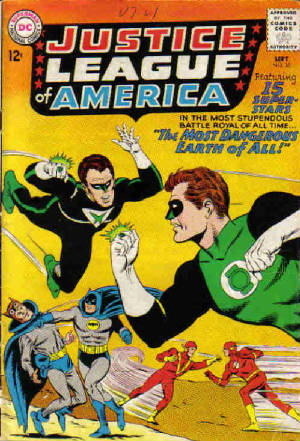
|
| click on photo for larger size |
| 1st appearance of the Earth 3 Crime Syndicate |
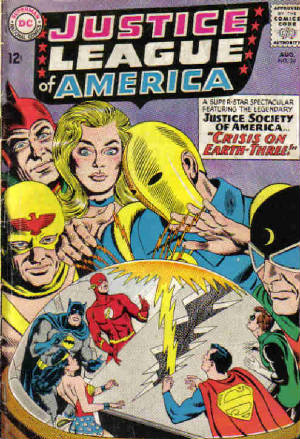
|
| click on photo for larger size |
| First teaming of Justice League with J. Society |
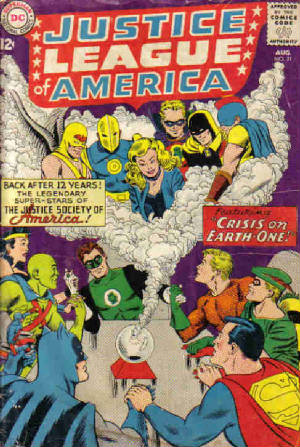
|
| click on photo for larger size |
| JLA # 107 |
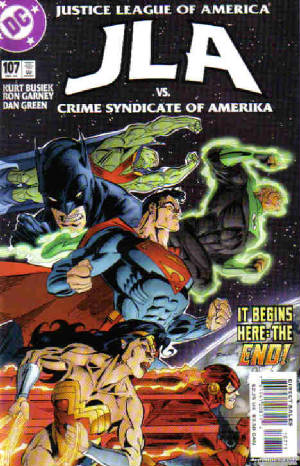
|
| The Crime Syndicate returned in 2004 - 2005 |
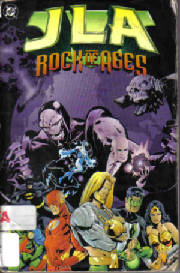 GRAPHIC NOVEL: JLA Rock of Ages.
This trade paperback collects the stories from the series JLA [only the initials were used for the title of this
particular Justice League series] # 10 – 15, originally published in 1997 and 1998. “Rock of Ages” is an
involved six issue story line wherein Lex Luthor leads the Injustice Gang (Joker, Mirror Master, Circe,
Ocean Master, Dr. Light) on another attack on the JLA. The story takes place when Superman was in his blue energy form, and
minor characters like Aztek were JLA members. As Luthor attempts to wipe out his enemies, some of the members of the JLA wind
up in a weird place called Wonderworld where giant Gods dwell. After this they are transported to the future where their minds
inhabit the bodies of their older selves. Darkseid has taken over the Earth and our heroes are told
they must prevent the JLA from destroying the powerful Philosopher's Stone that is
in Luthor's possession, although its destruction seems mandatory, if they are to prevent this dreadful
future from occurring. Unlike the Justice League of the sixties, these characters are more dimensional
but also more unpleasant, squabbling with one another and projecting attitude to spare. Grant Morrison's script and story
are inventive and absorbing. Howard Porter's pencils (inked by John Dell for the most part) are not as impressive, but the
cluttered panels do manage to pull one into the story well enough.
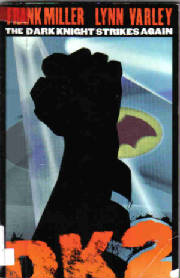 BATMAN: THE DARK KNIGHT STRIKES AGAIN. The other members of the Justice League, including Superman, Wonder Woman, The
Flash, Green Lantern, Captain Marvel, etc., play a big part in this stylish if imperfect adventure, the sequel to Frank Miller's
Dark Knight. In a horrible future world where the president is only a computer image, Lex Luthor holds the bottle city
of Kandor hostage, preventing Superman from striking out against him and pitting an angry, driven Batman against the Man of
Steel, whom he mistakenly sees as traitor, wimp, or both. A fast-moving, entertaining mini-series by Frank Miller, not as
“heavy” nor grim as the original, but the flippant, occasionally “campy” technique -- and the rather
obvious satirical material (nude newswomen and bimbo superbabes on TV) -- used to tell the story sometimes gets in the way.
[There are some moments of gratuitous ugliness, such as a reference to how Arkham asylum inmates eat their hostages, including
visiting students and “the day care center.”]. The Batman's young female assistant, in a ludicrous cat costume,
helps release many of the Justice League members from captivity so they can help in the Good Fight. A great touch has Ray
Palmer, The Atom, unknowingly imprisoned in a petri dish where he has to fight for his life against
“gigantic” lower life forms. The artwork is often effective and exciting, although it is also largely crude and
devoid of genuine eye-appeal. In a series of semi-erotic full page panels, Superman and Wonder Woman have a notable sexual
encounter in space. SPOILER ALERT: An embittered Dick Grayson turns out to be a savage antagonist of Batman's in this.
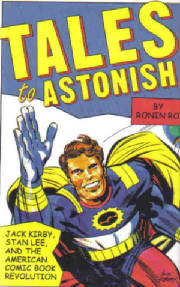 Tales to Astonish. Ronin Ro. Bloomsbury.
While most people expect there to be all sorts of internecine quarrels behind the scenes of, say, an opera company or
sitcom set, they may be surprised at all the squabbling that goes on behind the scenes of a comic book company. This highly
entertaining and readable book, ostensibly a biography of Jack Kirby, documents the heady early days and troubled later years
of Kirby, his frequent collaborator Stan Lee, Marvel Comics, and the other firms, including DC Comics, that they, especially
Kirby, were also involved with as time went by. With Joe Simon, Kirby created Captain America back in the Golden Age of Comics
during the forties. In the sixties, he and Lee collaborated on such characters as The Fantastic Four, The Hulk, The Avengers,
The X-Men, and many others. Kirby became disillusioned, then enraged by the perception that Lee – which he felt Lee
fostered -- was the sole creator and writer on these various strips, when Kirby did much of the plotting and creating himself.
Eventually Kirby left Marvel for rival DC Comics where he created his own “Fourth World” of comics characters
such as The Forever People, Mister Miracle, and The New Gods – but DC Comics was dissatisfied with
the books and canceled them prematurely. (Ironically, The Fourth World proved a major influence on the Star Wars movies
and most of Kirby's characters, particularly the villainous Darkseid, are now a big part of the DC Comics Mythos.)
It was also noted that Kirby's books suffered without the deft scripting of Lee, whose contribution to the Kirby-Lee comics
could not, in truth, be underestimated. Still, Lee got too much of the credit as far as Kirby, and many others in the comics
industry, felt. Ro's book is full of fascinating details such as how Kirby and Lee disagreed vehemently on the direction taken
by the character The Silver Surfer, who had a brief popularity, and the way that DC Editors had another penciller
replace Kirby's drawings of Superman's face so that the image would conform to the accepted version of the Man of Steel. While
it is utterly ludicrous to compare Kirby to the likes of Michelangelo(!), as one person does, this book makes clear that he
was an extremely talented and very influential artist whose imagery and style has resonated throughout the comics industry
for generations and will undoubtedly continue to do so for many years to come. -- William Schoell.
NOTE: Collection of Kirby-drawn comics covers below.
| Kirby co-created Captain America and Red Skull |
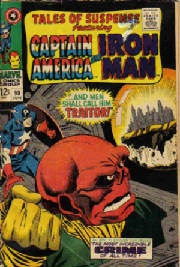
|
| click on photo for larger size |
| classic Kirby cover re-introducing Captain America |
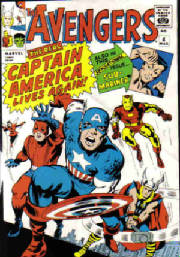
|
| click on photo for larger size |
| First issue of Kirby's NEW GODS |
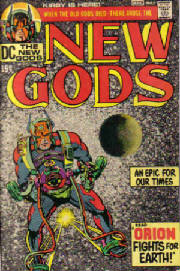
|
| click on photo for larger size |
| Kirby's FOREVER PEOPLE |
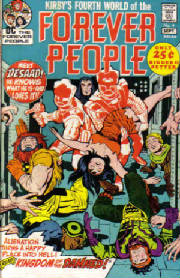
|
| click on photo for larger size |
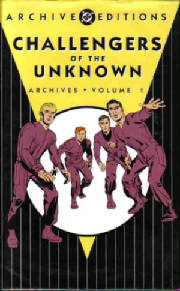 CHALLENGERS OF THE UNKNOWN Archive Editions; Volume One. DC Comics.
This hardbound volume collects the adventures of the Challengers of the Unknown, drawn by sole creator Jack Kirby, from
their first appearances in Showcase in 1957 and the first two issues of their own
magazine. The premise of the series was to present four brave men, tops of their respective fields, who “cheat death”
by walking away from a plane crash that, frankly, no one should (or could) have survived. No, they're not dead, but they do
decide, since they're living “on borrowed time,” to take on any challenge no matter how dangerous, risking death
on a continual basis. (Of course most people in their situation might run from dangerous
situations, figuring their luck couldn't possibly hold out.) The Challengers' adventures were culled from popular science
fiction and monster flicks, among other sources, and always had a certain colorful panache. The stories in the three issues
of Showcase were written by Dave Wood, while Kirby himself took over the writing chores
for the first two issues of their regular magazine, which each featured two stories instead of one full-length adventure.
“The Human Pets” in Challengers #1 is a harrowing tale wherein the heroes try to escape from a towering
alien child of tremendous size who wants to keep them for pets. [This may have influenced a similar story on The Twilight
Zone, not to mention the TV series Land of the Giants.] Kirby's work is generally quite good (if sometimes rushed and unspectacular) and “Ultivac is Loose”
in Showcase # 7 features some particularly dynamic penciling from the artist. The story concerns a giant rampaging
and misunderstood robot; when he's turned into a big computer console at the end you almost feel sorry for him. “The
Menace of the Ancient Vials” in Showcase # 12 features giant crooks (as in the
Doc Savage novel "The Monsters”) and a slithery sea monster called a kraken. Frankly, Challengers
of the Unknown was neither a great nor a trend-setting comic book, but for kids of all
ages it was fun, chock-full of monsters and maniacs. -- William Schoell
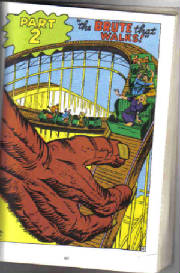
|
| Monster Masterworks |
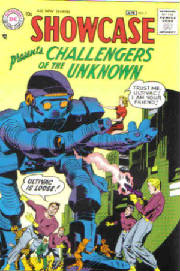
|
| Challengers take on Ultivac |
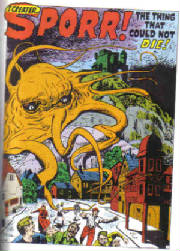
|
| Monster Masterworks |
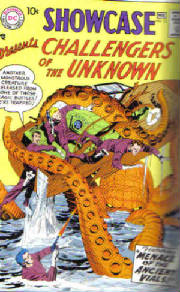
|
| Challengers versus the dreaded Kraken |
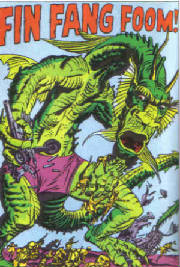
|
| The incredible FIN FANG FOOM |
MONSTER MASTERWORKS. By Lee, Kirby, Ditko and Ayers. Marvel Comics trade paperback. This volume
reprints stories originally published in the fifties and sixties and reprinted in the late sixties and seventies in such titles
as Where Monsters Dwell and Where Creatures
Roam. For some strange reason the table of contents lists the reprint title as where the story first appeared instead of the original title, which can sometimes be
gleaned at the bottom of the splash page (possibly because the plates where re-used from these reprint titles). Most of these
stories appeared in the twilight era between the golden age and silver age when super-heroes had temporarily faded in popularity
and science-fiction/horror/monster comics were all the rage. Most of Stan Lee's stories borrow heavily from popular movies
of the period, but occasionally he strikes gold, such as a story in which a magic typewriter brings an author's monstrous
creations to life; and a tale wherein ancient Aztec “three-dimensional” paint is used to depict on canvas a god-monster
which also comes to life. Perhaps the best story is “Titan, the Amphibian from Atlantis,” in which a gigantic,
intelligent sea creature looks for an earth traitor to give away all of the world's defense secrets, and a businessman named
Cartwright volunteers. Cartwright's name lives in infamy from that moment onward, although the world little dreams that far
from being a traitor he “volunteered” to help Titan simply so that he could feed him misinformation, for which
he pays the ultimate price. While many of the stories are common, silly retreads of typical monster movies, Lee's heroes aren't
generic, but suffer from all manner of woes and insecurities. They aren't always admirable. One dopey
guy swallows a potion to make himself bigger to impress his girlfriend, turns into “I am the Brute that Walks,”
and after going on a rampage, simply tells everyone that he “defeated” the monster after he changes back into
human form. The smart, brave hero of “Fin Fang Foom” is a young Chinese man who releases
a gargantuan dragon from his eons-long sleep so that he can defeat the Red Chinese Army and then has a hell of a time getting
the intelligent talking beast back into his cavern. (Many years later the dragon Fin Fang Foom appeared in a memorable series
of Iron Man stories, which recounted his origin, and introduced a whole slew of dragon monsters from space.) Steve Ditko drew
a couple of the tales in this volume, but most were penciled by Jack Kirby, whose work is often dynamic and effective. The
monsters are sometimes ludicrous, but often impressive – Fin Fang Foom is certainly a bizarre wonder to behold! Lots
of fun, and much more interesting than you might expect. -- William Schoell
CLICK HERE FOR A REVIEW OF SPIDER-MAN 2 ON OUR REVIEWS PAGE -- DVDs.
CLICK HERE TO READ ABOUT THE EARLY ADVENTURES OF THE FANTASTIC FOUR!
AND FOR THE REAL SUPER-HERO FAN, CLICK HERE TO GO TO THE NEW COMIC BOOK WEB SITE, SUPERHERO COMIC REVIEW.
Please pardon our appearance as we revamp this web site. A change in format has created some lay out
and photo problems which we will correct as soon as possible. Many thanks for your patience. -- The Editors
NOTE: press "home" on your keyboard to go straight back
up to the top
HIGH AND LOW NY: THE PERFORMING ARTS AND ENTERTAINMENT
NEWSLETTER
Entire contents copyrighted 2004 - 2005 by William Schoell and Lawrence
J. Quirk, except for items written by other authors, in which case said authors retain the copyright of their work .
Opinions expressed by individual authors and reviewers are not necessarily the opinions of High and Low NY.
|





